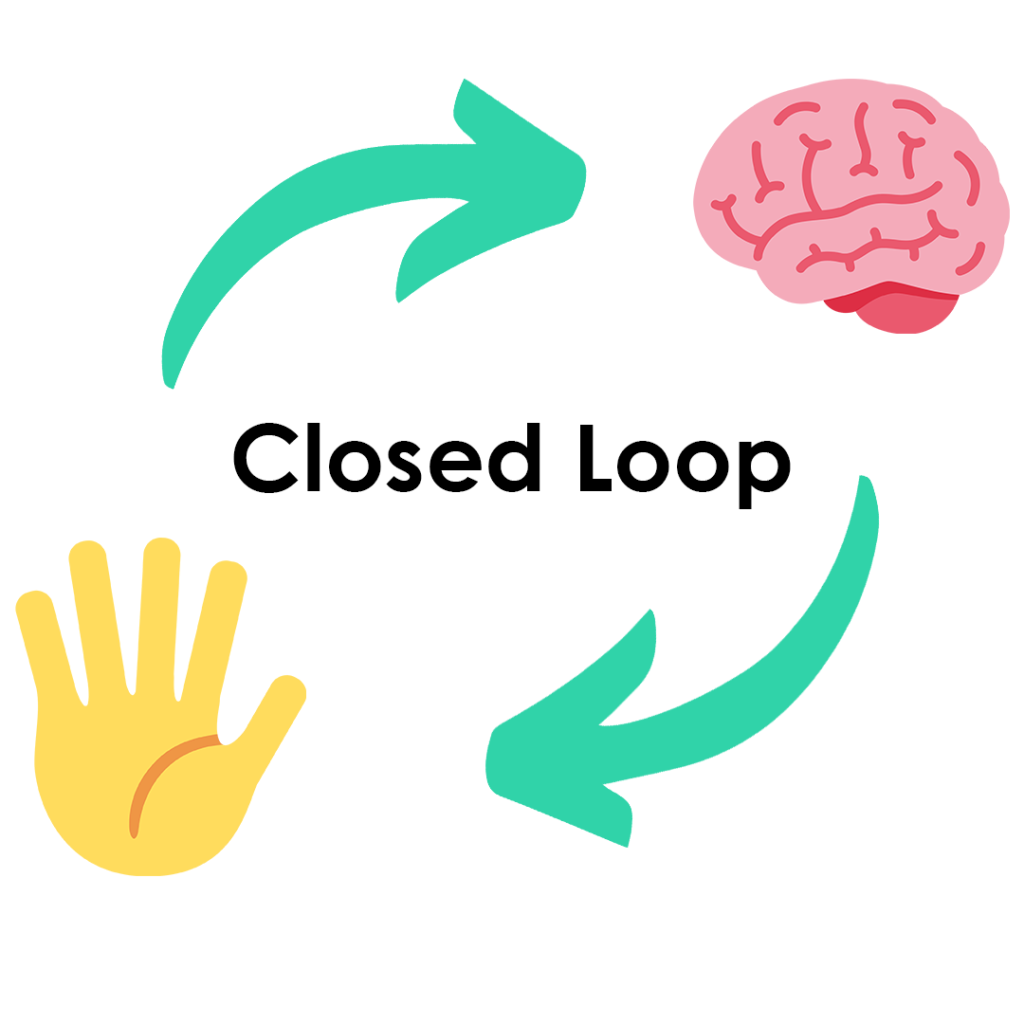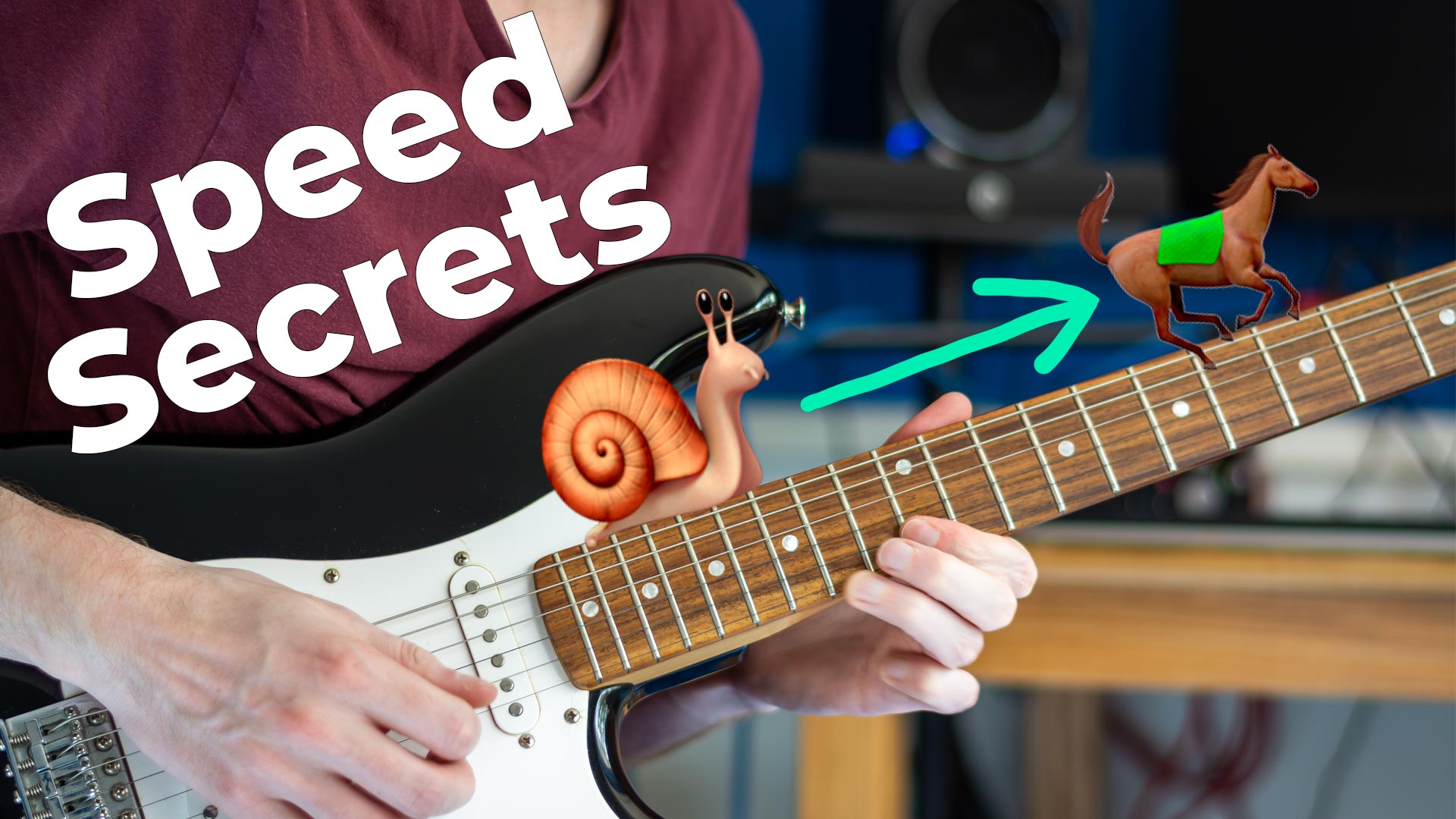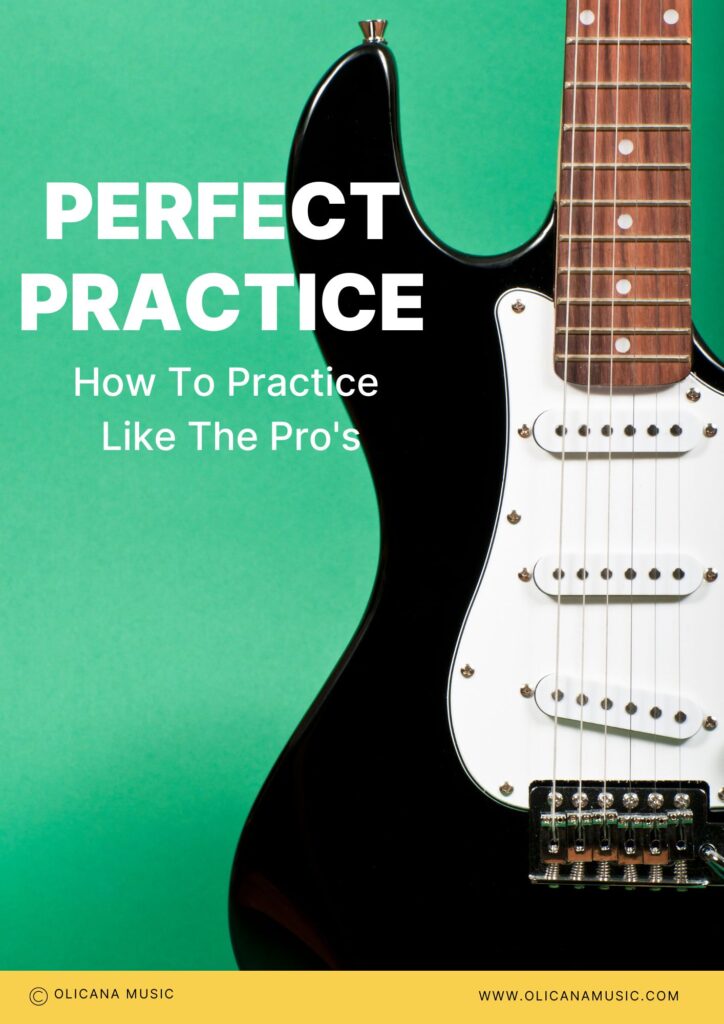Objectives
By the end of the lesson pack you will:
- Understand the concept of chunking and how to apply it.
- Be able to play a fast alternate picking phrase by using the concepts from the lesson.
Prerequisites
It would help to know:
- The basics of alternate picking.
- The natural minor scale.
What Is Chunking?
Chunking is a memorisation technique used for learning sequential information. You might have used it already to learn your phone number. In the UK a phone number is 11 digits, you might have it memorised in a sequence that goes something like:
12345, 123, 123
This is chunking in action. There’s a chunk that’s five numbers long, then two more chunks that are each three numbers long.
Chunking is not just useful for phone numbers – you can also use it for physical skills, for example you have probably memorised tying your shoe lace using a sequence of chunks. It’s is useful because it allows you to compress something complex, into something simple, so that is easy to recall and do. Trying to remember a sequence of 20 numbers is difficult without breaking the sequence into chunks. It’s much easier to break it apart and memorise the individual pieces.
Likewise when it comes to the complex movements that are required for fast guitar playing it would be unreasonable to expect yourself to remember a long sequence of individual steps. It’s much better to memorise a phrase as a series of discrete chunks and let muscle memory take care of what happens within each chunk.
Why Chunking Is Necessary?
Chunking is necessary to learn any fast phrase. This is because of the way the body works.
In sports science there is a field of study that focuses on a theory called motor programs. Motor programs are a way of describing how the brain stores and executes a sequence of movements. For example in order to throw a ball a motor program must be executed. Similarly playing a sequence of chords requires a sequence of motor programs to be fired.
There are two kinds of motor program, closed loop and open loop. The difference between the two is that a closed loop program can be changed as it is being executed. Whereas an open loop can’t be changed whilst its being executed.
Take the example of balancing on one leg. Here your brain uses a closed loop motor program to stay balanced. Your brain is incorporating feedback about your body’s position in space and balance to keep you upright. If you fall off balance your brain can adapt the motor program based on feedback from these senses to correct your balance and keep you upright. This is a closed loop because there is time for your brain to incorporate sensory information and adapt your movement based upon it.
In an open loop motor program there isn’t enough time for the sensory feedback to be acted upon. This is because by the time the feedback reaches your brain and the modified messages sent back to the limb in question the movement has already been completed. An example of this could be a tennis serve. By the time any feedback about the serve can be acted upon that ball has already hit the other side of the court.


In order to execute movements that take place in an open loop environment your brain in essence sends the information to your limbs in a single package. I.e. all the information that is required to complete a tennis serve is sent in one go. The quality of this package can only be evaluated after it has been executed.
Lets take the phrase we are going to learn today as an example. It’s a 16th note triplet phrase at 120bpm. At this tempo you will be playing 12 notes per second, this is 83ms per note. The average reaction time according to humanbenchmark.com is 215ms. This means that you’ll have played 2.5 notes by the time you have reacted to the first note. Clearly you cannot think about each individual note because there simply isn’t enough time.
When it comes to learning fast musical ideas, the amount of time between each note is so short that you don’t have time to make changes on the fly. Therefore these ideas take place in an open loop environment and your brain must send packages of information to your hands, not individual discrete movements. You can leverage this phenomenon by mastering these packages of movements individually, and then learn how to chain them together sequentially.
This packages of movements are called chunks. What we will learn in the remainder of this lesson is how to create these chunks, master them individually, and then chain them back together to form a complete phrase.
The Speed Accuracy Tradeoff
Before you start learning a fast musical phrase there’s something you need to know. The truth about learning to play guitar fast is that at some point you have to try to play faster than you’re comfortable. If you want to be a faster runner, you would need to try and run faster. The same logic applies to playing guitar fast.
Although not commonly espoused by teachers, you should be pushing yourself to play faster than you are comfortable, and in the process, making mistakes! This is how you develop speed and accuracy simultaneously. This isn’t just my own conjecture, there is research to support it. Scientists have studied children learning to play hockey to learn more about the speed-accuracy trade off. In this study they split the kids into two groups. One group trained their shots for accuracy, the other for power. Later they brought them back together and tested them to see which group had the best power AND accuracy. Which group did best in both categories?
It was the group that trained for power. They had better power and better accuracy than the group that trained for accuracy. It’s hypothesised that the reason for this is because the technique required to be both accurate and powerful is different from the technique required to be solely accurate. The group that trained only for accuracy lost that accuracy when they tried to shoot with power because they had not developed the required technique. This is the speed-accuracy trade off in action.
A powerful hockey shot has to be executed at a fast speed, this makes it an open loop motor program. What we can infer from this study is that if you want to be both fast and accurate (a movement that is an open loop motor program), you must practice the movement as an open loop motor program.
Practicing for accuracy doesn’t translate to power and accuracy. Practicing slowly won’t translate to playing fast – I’m sure you’ve experienced this, I know I have! If you want to play guitar fast, the speed should come first, then the accuracy can follow. Think of the mistakes you’re making as credit towards being able to play at the speed you want to.
How To Play Guitar Fast
So how do you play guitar fast? The answer is through a sequence of chunked open loop motor programs. Lets look at how to do this using this 16th triplet phrase.

Step 1 – Break it into chunks using the downbeat
This phrase has 36 notes in it. Rather than learn it all in one go you are going to break up into bitesize chunks and master one chunk at a time. Firstly you are going to break the phrase up on the downbeat. This will allow you to stay in time when you play fast because you are going to line up the first note of each chunk with the downbeat. The first note of each chunk will be the one you pay the most attention to.

Although this phrase has nice even groupings of six notes at a time, not every phrase will. However the same rules apply, break the phrase into chunks at each downbeat. You could have groupings of four, five, six, or any other number, in any combination. In my experience there should be at least three notes in a chunk and no more than eight for chunking to be effective.
If the chunk is too small you aren’t compressing the information enough. If the chunk is too big you are trying to cram too much information into it which makes chunking less effective.
Remember the only way you will learn and play this lick at 120bpm is by practicing it in an open loop environment. By breaking the phrase into chunks and ensuring that each chunk isn’t too large you ensure that you will be able to spot any mistakes you make whilst learning to play the chunk fast. Then you can try to correct the mistakes whilst remaining in an open loop environment.
Step 2a – Learn one chunk at a time
Now you have broken the phrase into chunks you can learn one chunk at a time. Starting with the first chunk learn to play it slowly. This ensures that when you try to play it fast you can tell if you’re playing it right or wrong. It should be slow enough that you can think about every note and be certain that you are playing it right. This means with the right finger and pick stroke.

Once you can play the chunk properly at a slow tempo you can ramp up the speed until you find the point where you can’t think about the individual notes any more or the chunk falls apart– this is the speed where the chunk becomes an open loop and is the minimum speed at which you should practice the chunk at from now on.
This speed is different for everybody so you need to pay attention to what the chunk feels like to play and try to spot the speed at which you shift from a closed loop to an open loop.
The reason for not practicing slower than an open loop tempo any more is because the phrase will never become fast if you practice in a closed loop environment. As stated earlier if you want to play guitar fast the speed should come first, then the accuracy can follow.
Now you have found your open loop tempo, play the chunk once at this speed. When you get it right once try to go a little faster again. If you make mistakes or the chunk falls apart that’s ok, keep trying it at that tempo until it clicks. This is like taking shots at a basketball hoop, keep trying to sink the ball, try to correct your previous mistakes on each new attempt, and eventually you will succeed.
Just as missing the basket ball hoop doesn’t make you more likely in to miss in future (so long as you are trying to hit the target). You aren’t going to learn the chunk wrong by making mistakes, so long as you spot them and try to fix them on your next attempt.
Eventually you will get it right at this speed, pay attention to what it felt like when you did right and try to do it again. With time the chunk will become more reliable and you will be able execute it at your current tempo on demand.
One important thing to remember is that you shouldn’t turn the chunk into a loop. This is because it prevents you from evaluating the quality of each attempt. You need to be able to spot any mistakes you make and try to correct them on your next go. If you loop the chunk mistakes you make tend to get ignored in favour of getting reps out. Focused practice is what matters here so make sure you spot mistakes and try to correct them as soon as you make them. The best way to do this is by making each attempt at the chunk it’s own discrete effort..
Once chunk one is at your target tempo, repeat this process for all the other chunks in the phrase. This should leave you with a series of fast, unconnected chunks, that we can connect together to make the full phrase.
Step 2b – How to use a metronome
Some people prefer to use a metronome for this kind of practice. Here’s how to do that.
- Learn the chunk slowly
- Start the metronome at a slow tempo where you know you can play the chunk correctly. Try to play the chunk correct once.
- When you get the chunk correct once, increase the bpm by five
- When you play the chunk correct once at this tempo, increase the bpm by five.
- Rinse and repeat eventually you will hit your target tempo, by increasing the tempo as soon as you get it clean once you ensure you are pushing yourself and this is how you will get faster.
At some point in your session you might hit a limit where you can’t do it cleanly anymore either keep trying at this tempo until you get it right or reduce the bpm by 10-20 and practice in that zone.
Improvement will be seen over the course of a few days of practice. The changes that occur in your brain that are necessary to improve the reliability of the open loop will happen during sleep. So just like going to the gym, make sure you getting good quality rest and not over practicing if you want to see optimal results.
Step 3 – Connect the chunks
Once each chunk is at the target tempo in isolation the final step is connecting the chunks together. To do this play the first chunk and the first note of the second chunk at a minimum of your open loop tempo. You want to focus on connecting the first note because often this will involve a string crossing or position shift that makes the connection more difficult.

Once you can do the that try to connect the two chunks as a whole. If you are finding that there are mistakes in the second chunk after the connection, try adding one note from the second chunk at a time until it is fully constructed.

When you do this you probably will find at some point the chunks cascade into one another and you can play both sequentially. This is the beauty of chunking. Because the chunk is sent as a single package of information, you can’t interfere with the middle of the chunk, at some point you pass over the threshold where the chunk just happens – this is what people refer to as muscle memory.
Now get these two connected chunks up to the target tempo using the methods used for the single chunks. To begin with it sometimes helps to accent the first note of each chunk so that you can feel and hear the start of each chunk clearly.
When you’ve done that add the third chunk in the same way that we did the second. Then keep repeating this process adding a chunk at a time until the whole phrase is built. Keep trying to land the first note of each chunk on the down beat, if you timing is good the subdivision will be fine, your hands will be in sync, the whole thing should sound great.
Adding Chunk 3


Adding Chunk 4


Adding Chunk 5


Final Thoughts
If you follow the process through in this lesson you should find you can play this phrase at whatever speed you like. If you’re struggling to get some part of it up to speed then work on the individual chunk that is causing problems, then add it back into the phrase as a whole.
It might take a couple of weeks to get this up to speed if it’s your first fast lick. But stick at it and I promise you’ll get the results you want. If you have any problems you can always get help in the community.



Ask your questions in the community